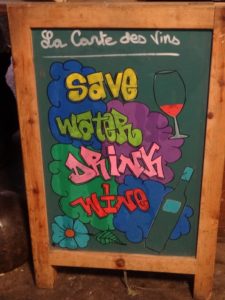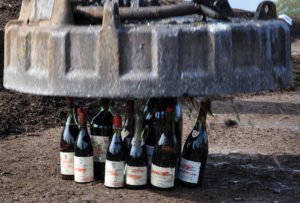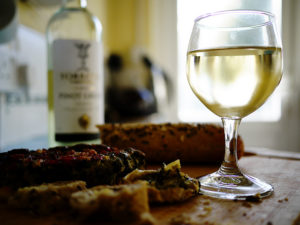It’s very difficult, if not impossible, for one single person to thoroughly review every single piece of peer reviewed literature related to wine that is published every day. This Wine Literature Review Lightning Round series presents three new papers (within the past year or two) in one post by briefly summarizing the research and linking to the abstract in order for you to pursue further if you’re interested.
DROUGHT AND CONSUMER PREFERENCES
As many living in California, Australia, South Africa, and many other regions around the globe know, drought is one of the biggest environmental problems facing agriculture/viticulture today. Not only is agriculture affected, but nearly every aspect of the environment feels the effect of drought and is also an ever-present public health issue worldwide. Concern for the health of our environment and mitigation of human-influenced effects of climate change has

Photo courtesy Flickr user Kathryn Greenhill
spurred many consumers to respond “with their wallets”, by purchasing more products dubbed better for the environment, including products that are made to reduce their water usage and overall water footprint.
A new study, published in the June 2018 issue of Wine Economic and Policy, aimed to evaluate consumers preference for water-saving wines, as well as their willingness to pay for these kinds of wines, with a focus on the younger consumer demographic.
Brief Methods
200 Italian university students and staff participated in this study.
Participants willingness to pay for water-saving wines were determined using an experimental auction mechanism. Specifically, the “Vickrey 5th price auction mechanism” was employed. For this “auction”, every participant was asked to submit a bid for each wine at the same time, with the highest four bidders winning the auction. The top four bidders are then required to pay the amount bid by the 5th highest bidder for the given wine.
Three different wines were auctioned off in this experiment: a “conventional” wine with no indications of water savings, a wine indicating water savings on the front label, and a wine indicating water savings on the back label. Questions related to demographics, personal values, environmental attitudes, and wine consumption habits were also asked and analyzed.
Brief Results/Conclusions
Overall, young Italian consumers were willing to pay more for water-saving wines than conventional wines. Wine consumption habits, trust in labels, and environmental attitudes also positively influenced willingness to pay in these young Italian consumers. Additionally, women tended to be willing to pay more for water-saving wines than men. (Note: participants varied in age from 19 to 32, with the average at 22 years old).
In general, this study showed that younger Italian consumers are willing to pay more for water-saving wines. However, it is important to note that this was a relatively small study, and also selective in terms of the participant pool, so the results can not be extrapolated to the whole population. These results are focused on young Italian consumers, whereas it is unclear what the results would be had a broader demographic been selected or how culture might influence willingness to pay for water-saving wines. Further research addressing these issues should be done before one assumes these results are applicable to other populations.
MACHINE LEARNING – TECHNOLOGY – WINE FRAUD
Wine fraud is a big problem globally, particularly when it comes to fine wines and investment wines. The more expensive something is, the more attractive it is to fraudulent activities. As a result, detecting and mitigating wine fraud has grown along with the practice, with new techniques and technologies tested on a regular basis.
One family of techniques used to classify many different products, including food products, is called “data mining”, which employs tailored computer algorithms to correctly distinguish certain products from one another. If a computer program can distinguish a specific type of

Photo courtesy Flickr user Office of Public Affairs
wine from another, then the technique could be useful in combating wine fraud, as the system would be able to detect that the wine in question is quite different than what it is supposed to be.
A new study, published in the May 2018 issue of the journal Measurement, aimed to distinguish between Syrah wines from Argentina and Syrah wines from Chile, using two data feature selection techniques: Support Vector Machines, and Multilayer Perceptron/Extreme Machine Learning.
Brief Methods
All wines were at least 75% Syrah from either Argentina or Chile, from the 2009 or 2010 vintages, and were between $1-50USD per bottle retail. A total of 26 Argentinian Syrahs and 11 Chilean Syrahs were analyzed.
Information on a variety of chemical parameters of the wines were measured and included in a database, which would later be analyzed and interpreted through the machine learning computer programs. Specifically, the following parameters were measured and analyzed in the programs: total polyphenols, total anthocyanins, antioxidant activity, several individual anthocyanins, and wine color.
Each computer program determines the most important features distinguishing individual wines and puts more weight on those specific features when performing their analyses. I will spare you all the mathematical details on how the programs actually work, but if you have specific questions I’ll do my best to relay the appropriate information you.
Brief Results/Conclusions
According to the analysis, the best combination of features that could distinguish Argentine from Chilean Syrah wines were the anthocyanins peon-3-glu, malv-3-glu, and pet-3-acetylglu, which with the Extreme Learning Machine program was able to distinguish the geographical origins of the wines with a 98.33% accuracy rating. Additionally, the Extreme Learning Machine program was more accurate in classifying wines from the two regions than the Support Vector Machines and the Multilayer Perceptron programs. The other programs only achieved up to 93% accuracy and they utilized between 7 and 9 different features, whereas the Extreme Learning Machine program was able to distinguish the wines with a 98% accuracy using only 3 features.
Further testing with more wines from different regions should be done to determine if this Extreme Learning Machine approach would be useful on a global scale to help prevent wine fraud and other issues related to wine authenticity.
WINEMAKING/ENOLOGY
As we all know, wine has a huge range of different aromas and flavors, some of which is well-understood, while some of which is more mysterious. According to the study I am about to present, “stone fruit” aromas are well-documented in wine tasting literature, however, it’s exact chemical origins remain unknown. Often times, “stone fruits” in wine are associated with peach, apricot, and nectarine-like aromas/flavors, though precisely which compound or compounds responsible for said flavors as not known.
A new study, published in the August 2018 issue of Food Chemistry, aimed to evaluate possible chemical sources of the “stone fruit” aroma using Chardonnay, Viognier, and botrytis Semillon wines.
Brief Methods
65 wines described as possessing “stone fruit” aromas by the label or winery tasting notes were included in this study. A group of experienced wine tasters than sampled these wines blindly and determined a final list of 10 wines confirming the presence or lack-there-of of the “stone fruit” characteristic to be included in the study analysis. The wines included in this study were: 4 Australian Chardonnays, 3 Australian Viogniers, 1 French Viognier, and 2 Australian botrytis Semillons. 5 of these wines were confirmed by the tasters to possess high stone fruit aromas, while the other 5 possessed negligible stone fruit aromas.

Photo courtesy Flickr user brett jordan
Grape samples were collected from 11 Viognier clones at a commercial vineyard in Eden Valley, Australia. Grape samples were taken just prior to harvest during the 2014, 2015, and 2016 vintages. Grapes were processed for chemical analysis.
Chemical analyses were performed on both wine and grape samples: pH, titratable acidity, volatile acidity, residual sugar, specific gravity, alcohol, and free and total sulfur dioxide.
After determining what compounds might be responsible for stone fruit aromas, model wines were spiked with these compounds and tested via sensory analysis by a trained panel to confirm or refute the findings.
Brief Results/Conclusions
Overall, this study found several compounds that may be responsible for the “stone fruit” aroma in white wines. Specifically, results showed that linalool and geraniol in Viognier wines, several esters in Chardonnay wines, and γ-nonalactone in botrytis Semillon wines may be at least partially responsible for the perception of stone fruit aromas in these white wines.
The results also showed that the compounds associated with “apricot” and “peach” aromas, namely γ-octa-decalactone, γ-deca-decalactone, γ-dodeca-decalactone, and δ-decalactone, were NOT responsible for the “stone fruit” aromas observed in the Chardonnay and Viognier wines in the study. On the other hand, γ-nonalactone might influence “stone fruit” aromas in botrytis Semillon wines.
In general, this study shows that the “stone fruit” aroma in white wines is a complicated beast, and despite the results in this study is still not well understood. Like many things related to wine, there is no cut and dry answer to this question. From this study, it appears as though “stone fruit” aromas are elicited by different compounds, depending upon what variety or type of wine you’re looking at. For Chardonnay, perhaps it’s a combination of specific esters that determine how much “stone fruit” you’ll observe, while with Viognier, it may be more a factor of monoterpene concentrations. Regardless, this study provides some insight on the complicated nature of “stone fruit” aroma in white wine, and one of which requires much more study.
